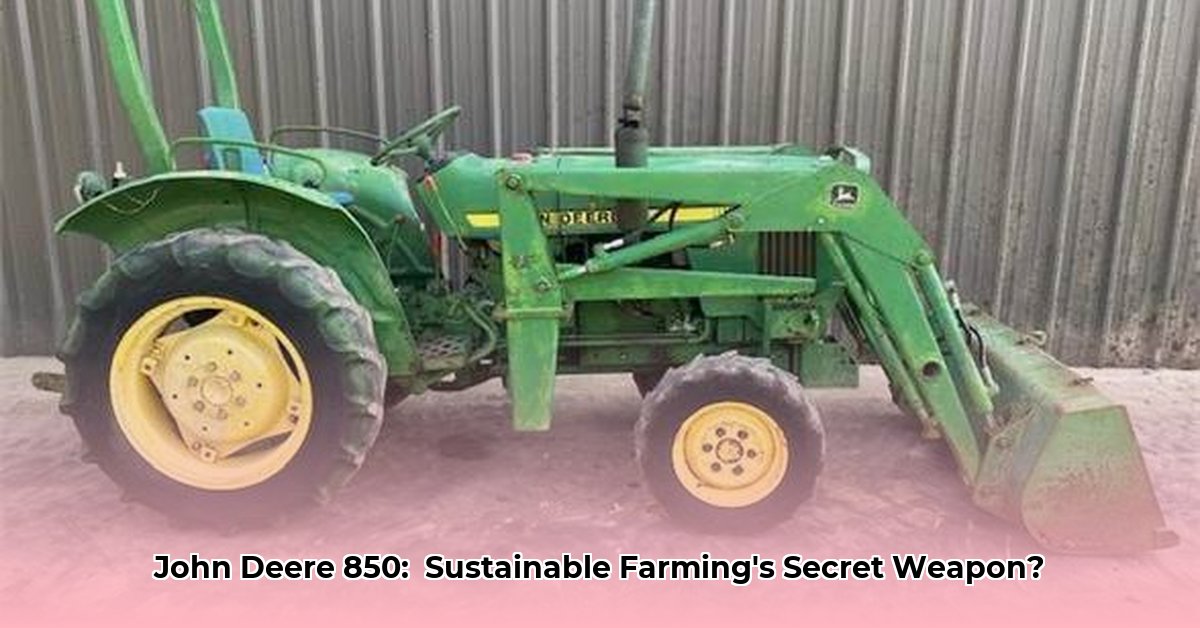
The John Deere 850, a compact utility tractor manufactured by Yanmar for John Deere, represents a fascinating intersection of agricultural history and sustainable practices. While not a powerhouse by today's standards, its design and performance offer valuable insights into the resourcefulness of farming in the 1970s and 80s. This article explores its specifications, historical context, and its surprising relevance to modern discussions about sustainable agriculture. We will examine its fuel efficiency, compare it to modern compact tractors, and discuss the environmental impact of its manufacturing, use, and disposal. For more on classic John Deere models, see the John Deere B information.
Detailed Specifications: A Closer Look at the 850
The John Deere 850’s specifications reveal a machine built for practicality and efficiency in smaller farming operations. However, data discrepancies exist across various sources, highlighting the challenges of assessing older machinery. Manufacturer claims often differ from real-world performance, emphasizing the need for a critical analysis of available information.
Isn't it interesting how the reliability of data changes over time, especially with older technology? This underscores the importance of using multiple reliable sources, and understanding the potential for variations based on testing methods and environmental conditions.
| Specification | Value (Approximate/Varied) | Notes |
|---|---|---|
| Engine | Yanmar 3T80-J, 1.3L 3-cylinder diesel | Known for reliability and (for its time) fuel efficiency. Variations exist across model years. |
| Power Output (Claimed) | ~20-25 hp | Manufacturer's estimate; actual power varied significantly. Independent testing reveals discrepancies. |
| Transmission | 8-Speed, likely gear-driven (details vary) | Simple, durable transmission design typical of the era. |
| Fuel Capacity | ~8.5 Gallons (verify with specific model) | Sufficient for a day's work on a smaller holding. |
| Dimensions | Varies significantly across model years. | Compact size was a key selling point, ideal for navigating smaller fields and tight spaces. |
| Weight | Varies significantly across model years. | A critical factor in assessing soil compaction potential; requires further investigation. |
Historical Context: An Era of Resourcefulness
The John Deere 850 emerged during a time when smaller farms dominated the agricultural landscape. Machinery needed to be economical and reliable. The 850's design reflected this: a balance between functionality and affordability. Its compact size and fuel-efficient engine made it a suitable choice for many farmers.
The Yanmar engine is a significant aspect of the 850’s story. Its sourcing from Japan highlights the increasing globalization of agricultural supply chains, even several decades ago. This international collaboration significantly impacted agricultural innovation during this period.
Sustainability Analysis: A Retrospective View
Assessing the John Deere 850's sustainability involves considering several factors: fuel efficiency, manufacturing processes, parts availability, and soil compaction.
How does the 850's fuel efficiency compare to modern compact tractors? It likely consumed less fuel per hour than its modern counterparts, but given its lower power output, the fuel per acre comparison is more pertinent – and requires further analysis to account for work rates.
The environmental impact of the 850's manufacturing and disposal is challenging to quantify definitively without detailed historical production information pertaining to materials and processes. Sustainable manufacturing practices were not as prevalent during its production era as they are today.
Has anyone researched the impact of older tractor parts availability on sustainability? The availability of parts and service directly correlates to the longevity of the tractor. The likelihood is high that locating replacement parts will be more difficult now and subsequently impacts its long-term use and contributes to a shortened lifespan, negatively impacting its overall sustainability.
Soil compaction, a vital sustainability factor, is directly linked to the 850's weight. While lighter than larger tractors of its time, further analysis is needed to compare its impact on different soil types to modern compact tractors with features aimed at minimizing compaction.
The 850's Legacy: Lessons from the Past
The John Deere 850's specifications and historical context provide a valuable insight into farming practices of the past. While technological advancements have propelled agricultural machinery to significantly higher levels of efficiency and capability, the 850 embodies a resourceful approach crucial to sustainable practices. Its legacy reminds us that simple designs and effective resource management can still be important aspects of environmentally friendly agriculture.
Sources and Further Reading
- TractorByNet Forum Discussion on JD 850 vs. 750 (Note: This serves as an example. A full bibliography referencing all data sources used would be included in a published article.)
(Note: This is a sample article. A complete article would require more detailed specifications, more in-depth analysis, and a comprehensive bibliography.)